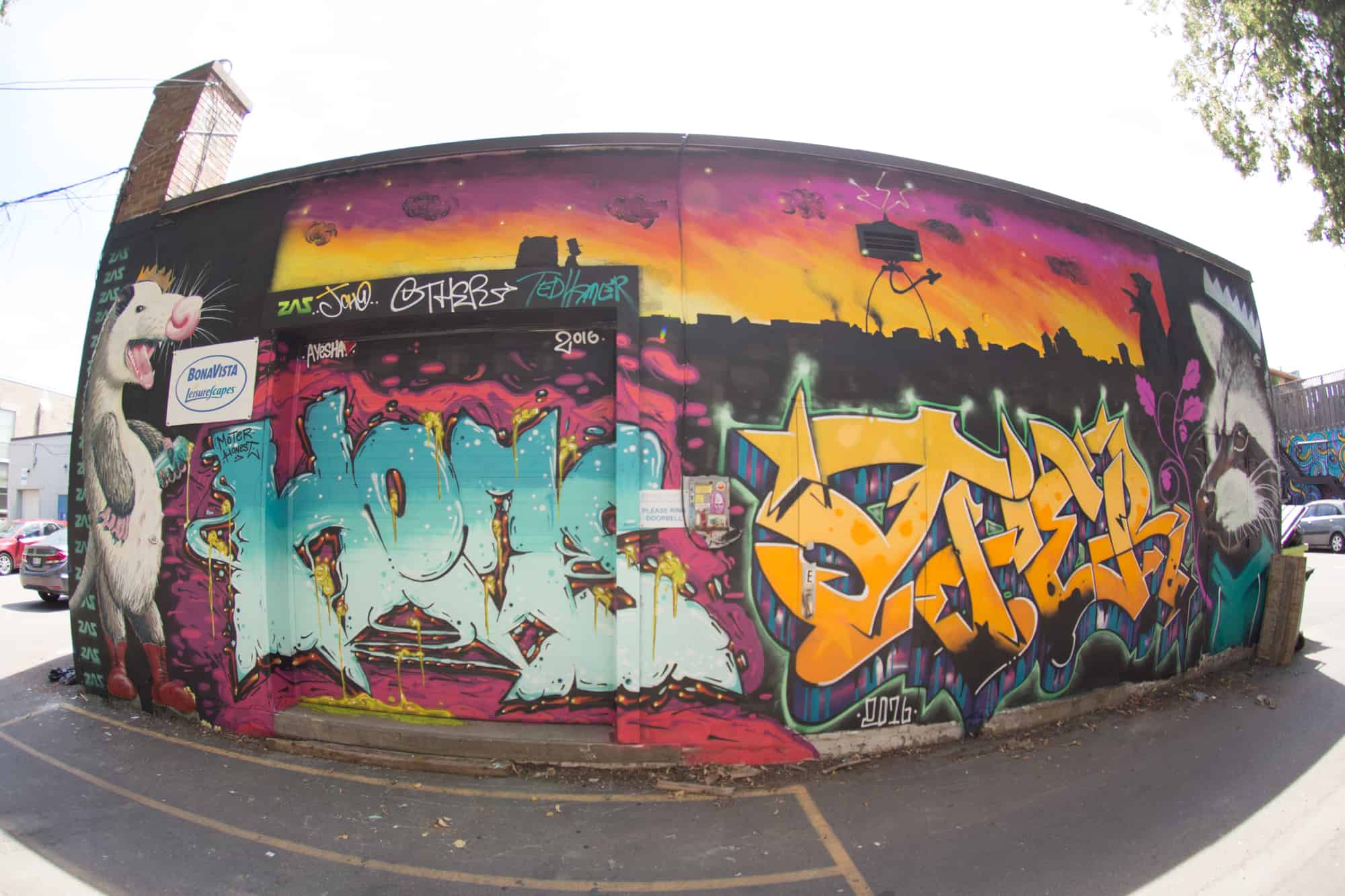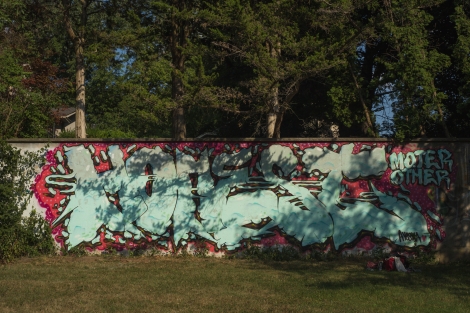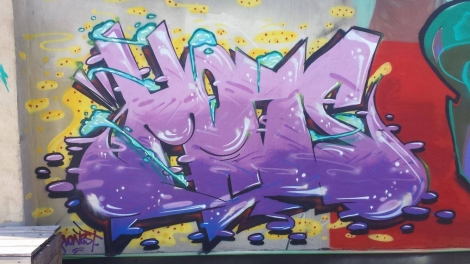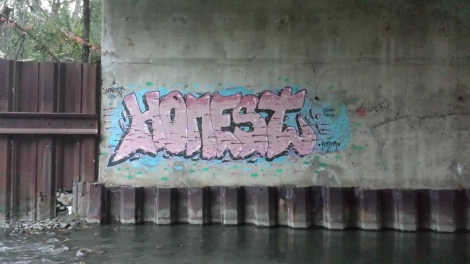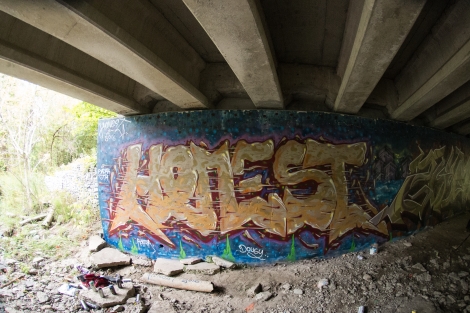Every time I go to Sneaky Dee’s, I feel compelled to vandalize. Equating my chicken scratch with graffiti would be an insult to any respectable artist, and one can hardly call me rebellious when the bar is virtually plastered with tags. Yet I take comfort in ritualistically inscribing a place that appears welcoming to my name: the idea is that, no matter how invisible I might feel in Toronto’s sea of people, what I write will remain scrawled into the back of a bar bench.
Toronto is home to an unquantifiable amount of graffiti. From spray-painted tags to beautiful murals, its transformation continues by the day, allowing new colours, messages, and ideas to pervade the deepest corners of the city.
At the same time, a substantial portion of the Toronto community views graffiti as a nuisance. Though the city has selectively legalized graffiti in certain neighbourhoods — such as Rush Lane near Queen Street West — it maintains a coercive grip on unregulated art. Graffiti can be considered an infraction under city bylaws, or even “mischief” under the Criminal Code of Canada, and the Toronto Police continue to urge communities to be vigilant of so-called vandals.
The criminalization of street art has driven it underground, meaning that it is impossible to even begin to understand it without an insider’s perspective. Enter ‘Honest’ — an artist who, for years, has contributed his artistic talents to this collective process of decoration. Born in Colombia and inspired by street art when living in Miami, Honest is now based in Toronto and has painted numerous works of art within the city’s borders and beyond.
Speaking with Honest drew my attention to the ways in which street art brings real colour to Toronto communities, defining not only how they look but also what their members stand for.
Why paint?
One unique benefit of street art is that it can connect people to the city. Far from sequestering itself in a studio or a gallery, it is an accessible art form — one that turns the city’s very walls into a canvas and encourages people to experience the outdoors.
The places Honest has painted are connected to my own paths through the city. One of his murals is sprawled across a roadway near my childhood home, while another is found in an alleyway I used to take to work. It is interesting to think that following somebody’s tag might take you on a journey further away from home than you might expect.
Preferring the north or east end to more “oversaturated” downtown haunts, Honest frequently paints art in unexpected places. Speaking to a piece he did in a wooded corner of a park, he said, “A dog walker would be going through this forest, and all of a sudden there’s this huge mural there. That’s the beauty of it. It’s sparking a reaction in these people when they’re not necessarily expecting to see it… It brings life to an environment.”
Beyond just being nice to look at, street art also serves an instrumental political purpose. Graffiti continually peaks in response to periods of social unrest around the world, and has communicated messages of resistance throughout history, from the Berlin Wall to the Israeli-Palestinian West Bank.
Honest has long identified with the political sentiment associated with his line of work. Regarding what drew him into street art, he explained, “I saw a lot of flaws in the way society was constructed… [Graffiti] was almost a way of rebelling against that. Saying ‘fuck this,’ you know, ‘I’ll do what I want.’”
Street art can also be a way for the marginalized, who otherwise lack the financial or political means to express themselves in a public forum, to share their stories. I spent hours walking through the alleys of San Francisco’s Mission District last summer. The Mission, home to the highest concentration of Latino people and Latin American immigrants in the city as of 2009, is painted with dozens of murals conveying the community’s struggles with immigration, police brutality, and violence.
Yet a political dimension to graffiti exists regardless of what a given mural might display. As a creator, Honest values the importance of making decisions for himself, not relying on the permission of the city to dictate where his art is permitted to flourish.
A movement and a following
It is this rejection of traditional modes of social order and control that continues to resonate with so many artists, allowing the graffiti scene to expand into what it is today. This is compounded by the captivating prospect of making a mark on the city and leaving something for the next person to find.
“It’s almost like you’re leaving messages behind throughout history,” Honest said.
Whilst promoting individuality, graffiti also brings artists together. A multiplicity of subcultures exists within graffiti circles; in particular, Honest clearly distinguishes between “taggers” — those who vandalize for the sake of destruction — and artists who create for beauty and enjoyment.
Though he places himself firmly in the latter camp, he said, “It’s kind of interesting to see how one thing can spiderweb into different elements of creating art.”
Where there’s a market, there’s an audience, and the rise of social media has facilitated the spread of art at unprecedented rates. During our conversation, Honest recalled ‘writer’s benches’ — places in the city where creators would gather and meet. Now, a complementary community has developed on platforms like Instagram, allowing followers to capture and trace work from all over the world.
Honest told me about groups of artists who paint trains, essentially ensuring that their work will be physically transported across North America to waiting spectators who gather in train yards. Other artists take what are known as “spraycations,” going on tours and painting cities around the world.
A cornerstone of graffiti culture is anonymity — important not only for evading apprehension by law enforcement, but for keeping audiences guessing and breathing mystery into the art itself.
“The style begins to develop its own persona,” Honest explained, speaking to how fans begin to speculate about their favourite artists. “People start imagining who this person looks like based on their style. Somebody has a very sharp, crazy, wild style, they’ll begin to incorporate who that person might be.”
Networks of creators
Honest refers to the artistic community itself as closed and nepotistic. Becoming respected as an artist means undergoing a gradual process of introductions and associations, working yourself up and associating with more famous creators.
“People have to respect you and know who you are in order for them to open up to you,” he said. “It’s very difficult to break into that world if you don’t know anybody.” We both laughed when I pointed out that what he was describing sounded a lot like my own professional community, where networking and LinkedIn connections are the only way to stay afloat.
It took Honest almost five years to become renowned, and even now he avoids stepping on any toes. As he told me, the best places to paint in the city are ideally kept secret in order to enable artists to steer clear of tourists or police officers. What Honest considers Toronto’s graffiti “wall of fame” — a sequence of tunnels near Bathurst and Sheppard — is restricted to skilled artists with permission to paint in that space.
What this also results in is a sense of territoriality and a condemnation of people who show no concern for boundaries. On one occasion, one of the spots Honest frequented was encroached by an outsider, one who further disrespected the space by leaving a mess of paint cans in his wake.
To me, Honest’s description of his community is enigmatic — simultaneously a rejection of societal norms, as well as a quasi-enforcement of structure that seems to have developed within respected street art circles, promoting a level of order even in the context of anarchy.
“As destructive as it may seem in a way, there’s still a morality behind it,” Honest said. Speaking to the general refusal to paint on schools or places of worship, he added, “There’s a code of ethics that you try to follow… There’s places you tend to respect.”
Those who fail to respect the community’s codes of conduct are inevitably pushed out. This might prompt artists to refuse to paint with one another, or even vandalize one another’s work. “It’s kind of ironic because you’re trying to get away from politics, but then you end up making your own politics within the community,” Honest said.
Though community ties can run deep, Honest’s attitude seems more relaxed. “At the end of the day, it’s paint on a wall,” he stated.
From crime to community
In light of its wide-reaching impact on community members, people might question what the city’s response to graffiti ought to be. According to Honest, Toronto is beginning to adopt more favourable attitudes towards the street art community, meaning that prospects for artists are getting brighter.
Instead of spending money trying to ‘clean up’ the city, one possibility is to contract graffiti artists like Honest to paint murals over tagged walls. Considering the persistence of street art despite efforts to stamp it out, it may in fact be more cost-effective to go with the flow.
In the summer of 2016, alongside other artists, Honest worked on a project with the StreetARToronto program that aimed to refurbish alleys near Eglinton Avenue and Laird Drive. Their goal was to tackle scrawled and bedraggled walls in vandalized parts of the community, replacing the mish-mash of tags with their own artwork. The event was sponsored by Toronto Police, who provided paint free of charge.
Similar to how murals in the Mission are supported by San Francisco community organizations, StreetARToronto suggests that there is hope in terms of collaboration. All parties, law-abiding or not, appear to share a common goal: keeping the city beautiful.
Yet it is not quite so easy to dispel tensions between graffiti artists and law enforcement in light of continued criminal associations with the activity. As Honest told me, one officer at the event, despite her friendliness, carried a binder and tracked artists’ tags throughout the process, presumably trying to put faces to identities for future reference. Honest considered this dubious.
“Toronto Police tries to make programs or collaborate with the city to create safe spaces for people to paint,” he said. “That can’t happen if you’re going to do stuff like that, because you automatically lose trust with people.”
Honest also believes that if the city wants to encourage cooperation from the community, they have to be careful who they choose to work with. “Sometimes they’ll hire some street artist who’s never been around the city, who doesn’t know much about the culture, and they’ll get him to paint murals,” he explained, frustrated. “Whereas the guys who have been around are like, ‘Why is he getting that job? Why is he getting paid to do that?’”
Despite having had run-ins with the law himself, Honest thinks graffiti should stay illegal. Although collaborations between artists and city officials might become more common, perhaps it is for the best that the community remains closed. If street art were legalized, it could mean sacrificing the liberation provided by its rejection of societal rules.
Indeed, the alluring shroud of mystery surrounding the community forges connections between artists and their followers, making those connections all the more personal when individuals relate to the messages on the walls.
Weeks after my interview with Honest, I walked by one of his stickers plastered on a mailbox near U of T. The encounter filled me with comfort. Amidst the hundreds of thousands of tags in my hectic neighbourhood, I now have a name to look out for.

